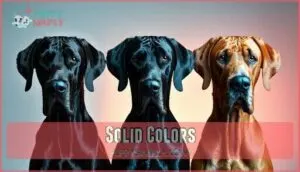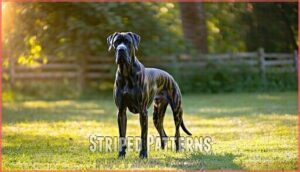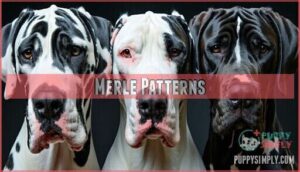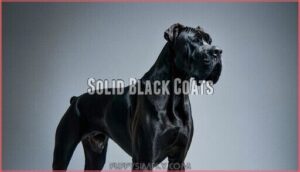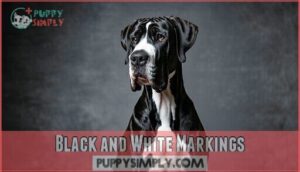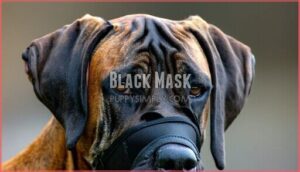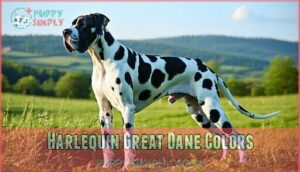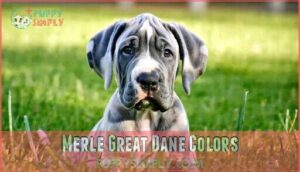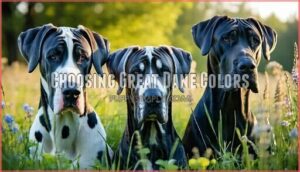This site is supported by our readers. We may earn a commission, at no cost to you, if you purchase through links.
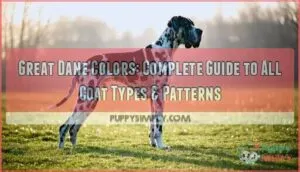
These gentle giants wear their coats like designer suits – some sport solid colors while others showcase stunning patterns.
Fawn and brindle are the most common, while harlequin creates that striking black-and-white spotted look that turns heads at the dog park.
Blue Great Danes aren’t actually blue but display a beautiful steel-gray shade.
Don’t forget about rare colors like chocolate and silver that exist outside show standards.
Each color carries unique genetic traits and potential health considerations worth understanding, especially for gentle giants and their rare colors.
Table Of Contents
- Key Takeaways
- Great Dane Color Variations
- Great Dane Coat Patterns
- Black Great Dane Colors
- Harlequin Great Dane Colors
- Merle Great Dane Colors
- Choosing Great Dane Colors
- Frequently Asked Questions (FAQs)
- What is the rarest color of Great Danes?
- How many colors do Great Danes come in?
- What is the most sought after Great Dane color?
- Are Harlequin Great Danes rare?
- What is the average life expectancy of a Great Dane?
- How often should I groom my Great Dane?
- What kind of food should I feed my Great Dane?
- What are the signs of a healthy Great Dane?
- Are there any special care considerations for elderly Great Danes?
- Do Great Dane colors change with age?
- Conclusion
Key Takeaways
- You’ll find Great Danes come in 24 color variations, but only seven are AKC-recognized: black, blue, brindle, fawn, harlequin, mantle, and merle, with fawn being the most popular choice.
- You should prioritize health over appearance since rare colors like white and double-merle carry serious genetic risks including deafness, blindness, and other health complications.
- You can’t breed two harlequin or merle Great Danes together safely – this creates double-merle offspring with severe health problems, so you’ll need to pair them with other colors instead.
- You’ll get the best companion by focusing on temperament and health testing rather than coat color, since a dog’s personality and wellbeing matter more than their appearance.
Great Dane Color Variations
You’ll discover that Great Danes come in 24 different color variations, though the American Kennel Club only recognizes seven as standard breeding colors.
These gentle giants showcase everything from classic fawn and brindle coats to striking harlequin patterns, with each color carrying its own genetic traits and breeding considerations.
Standard Colors
The AKC recognizes seven standard Great Dane colors that define the breed’s official appearance.
You’ll find black, blue, brindle, fawn, harlequin, mantle, and merle meeting strict breed standards for showing Danes.
These AKC-recognized colors result from specific color genetics passed down through generations.
Fawn remains the most popular choice, while color popularity varies among breeders following established Great Dane breed standard guidelines, which are based on the breed standards.
Non-Standard Colors
Beyond the seven standard colors lies a fascinating world of nonstandard variations that captivate Great Dane enthusiasts.
These rare great dane colors showcase genetic diversity but come with breeding challenges. Given this variety, it’s important to remember that responsible breeders prioritize health and adherence to standards.
Here are five notable non-standard Great Dane colors you’ll encounter:
- Chocolate Danes – Rich brown coats from recessive genes
- White Danes – Pure white with rare health risks
- Merlequin Pattern – White base with merle patches
- Fawnequin Genetics – Harlequin with fawn markings
- Doublemerle – High-risk breeding outcome
Rare Colors
Some rare Great Dane colors exist outside breeding standards, creating unique but challenging genetics.
Fawnequin genetics produce stunning white coats with fawn patches, while chocolate variations offer rich brown tones.
Blue brindle combines steel-blue with striping patterns.
Piebald patterns create irregular white patches.
However, doublemerle and white health risks make these nonstandard colors risky breeding choices despite their visual appeal.
Great Dane Coat Patterns
You’ll find Great Dane coat patterns fall into four main categories: solid colors like pure black or fawn, spotted patterns including the striking harlequin, striped brindle patterns with their distinctive tiger-like markings, and merle patterns with their unique gray base and black spots.
Understanding these pattern types helps you identify what makes each Great Dane’s coat special, whether you’re considering adoption or simply admiring these gentle giants at the dog park.
Solid Colors
With solid genetics behind them, these uniform appearance coats showcase pure color intensity that meets breed standards perfectly.
Your black Great Dane displays deep, glossy richness, while blue Great Dane coats reveal steel-blue elegance.
The beloved fawn Great Dane presents warm golden tones with signature black masks.
These standard colors represent Great Dane colors at their finest—no patches, stripes, or mixed patterns.
Rare solids occasionally emerge through careful breeding programs to produce a uniform appearance.
Spotted Patterns
Spotted patterns create striking visual drama in Great Danes, featuring distinct patches scattered across a white base.
Harlequin Great Dane coats showcase irregular black markings with varied patch size and spot distribution. Merle Great Dane patterns display gray backgrounds with darker spots.
Merlequin Great Dane genetics combine both patterns, while Fawnequin variations replace black with fawn. Great Dane markings differ substantially from Dalmatian comparison, creating unique coat patterns with distinct patches and varied patch size.
Striped Patterns
Brindle great dane coats showcase nature’s artistry through distinctive tiger stripes across their golden-yellow base.
You’ll notice how brindle genetics create these stunning chevron patterns, though breeding challenges make certain stripe variations quite rare.
Some dogs display reverse brindle, where fawn influence creates lighter stripes on darker backgrounds.
Like some German Shepherds, Great Danes can also display unique sable coloring.
- Classic brindle: Black stripes on golden-yellow foundation
- Reverse brindle: Light stripes dominating dark background
- Dense striping: Tightly packed patterns creating rich texture
- Sparse striping: Widely spaced stripes showing more base color
Merle Patterns
Three distinct merle variations create stunning visual appeal in Great Danes.
You’ll recognize the classic merle great dane by its gray base with irregular black spots, while merlequin great dane combines white patches with merle markings.
Double merle results from poor breeding ethics, causing serious health issues.
Pattern distribution varies widely, making merle genetics complex but fascinating.
| Merle Type | Key Characteristics |
|---|---|
| Classic Merle | Gray base with black patches |
| Merlequin | White base with merle markings |
| Blue Merle | Diluted gray with darker spots |
| Chocolate Merle | Brown base with darker patches |
| Double Merle | Mostly white, serious health risks |
Black Great Dane Colors
You’ll find black Great Danes showcase one of the most striking and elegant coat variations in the breed, with their glossy solid black coats creating a truly majestic appearance.
These dogs can display pure black coloring without any markings, black coats with white patches on the chest and feet, or serve as the foundation for the distinctive black mask pattern you’ll see on fawn and brindle Great Danes, which is a striking feature.
Solid Black Coats
Black Great Danes showcase stunning solid black coats that gleam like polished obsidian.
Midnight majesty walks on four legs—your black Great Dane commands attention with regal, obsidian elegance.
You’ll notice these dogs display pure, glossy black genetics without any markings absence being a flaw. Their coat glossiness reflects excellent health and proper care.
Breeding challenges arise when maintaining this solid black standard, as other great dane coat colors can interfere with desired outcomes.
- Midnight majesty: Your black Great Dane commands attention with their regal, commanding presence
- Living shadow: They move like elegant darkness, graceful and mysterious in every step
- Velvet companion: Their glossy coat feels luxurious, inviting endless gentle touches and admiration
Black and White Markings
While solid black coats create stunning elegance, black and white markings add striking contrast to your Great Dane’s appearance.
These color distribution patterns include white spotting on the chest, paws, and legs.
Mantle Great Danes showcase the most dramatic black and white combinations, featuring precise white markings against deep black backgrounds, creating tuxedo-like elegance that distinguishes them from standard black variations.
The American Kennel Club recognizes seven official colors for Great Danes, which include a variety of color patterns and the distinctive mantle appearance.
Black Mask
The distinctive black mask creates a striking facial feature that defines many Great Dane coat patterns.
You’ll find this darker pigmentation covering the muzzle and extending around the eyes in fawn and brindle dogs.
Here’s what determines mask development:
- Mask genetics control pigment distribution across facial features
- Intensity variation ranges from light to deep black coverage
- Breed standards require clear mask definition in show dogs
- Mask prevalence appears most commonly in fawn varieties
Harlequin Great Dane Colors
You’ll recognize harlequin Great Danes by their striking white coats decorated with irregular black patches that create a distinctive spotted pattern.
This eye-catching color combination requires careful breeding considerations since pairing two harlequins often leads to health complications in their offspring.
White Base With Black Patches
Harlequin Great Danes showcase a striking white base with irregular black patches scattered across their coat.
Unlike the mantle great dane’s structured black and white pattern, harlequin pattern irregularities create a unique spotted appearance.
Patch size varies dramatically, from small spots to large markings.
The breed standard requires torn, uneven patch distribution rather than symmetrical designs, making each harlequin truly one-of-a-kind.
This contrasts with the panda German Shepherd, which also features unique black markings, highlighting the distinction between these breeds and their unique appearances, with irregular patterns.
Breeding Recommendations
Two breeding approaches dominate Great Dane breeding when you’re working with harlequins. Cross your harlequin with a mantle instead of another harlequin—this prevents dangerous double-merle offspring.
Ethical breeding practices demand health screenings before any breeding combinations. Color genetics shouldn’t drive your puppy selection; temperament focus matters more.
Harlequin Great Dane products are available for owners. Great Dane breeding requires understanding coat color genetics for responsible breeding practices.
Health Risks
While breeding creates stunning harlequin patterns, you’ll face significant health risks.
Color-related deafness affects up to 40% of white danes, and merle breeding risks compound when producing double-merle offspring.
Fawnequin health complications include vision problems and genetic predispositions to sensory deficits.
Great Dane genetics make certain coat colors beautiful but potentially problematic for your dog’s wellbeing.
Merle Great Dane Colors
You’ll recognize a merle Great Dane by its distinctive light to dark gray base coat decorated with irregular black patches that create a marbled appearance.
This newest AKC-recognized color presents unique breeding challenges since pairing two merle parents often produces white puppies with serious health complications, which can be a significant issue for breeding.
Gray Base With Black Spots
Many people confuse merle great dane patterns with solid blue coats, but merle genetics create something entirely different.
You’ll notice a light to dark gray base decorated with irregular black spots throughout. These merle variations showcase stunning coat colors that make each dog unique.
The merlequin great dane combines this beautiful merle pattern with harlequin characteristics, creating extraordinary great dane color genetics. This pattern isn’t naturally occurring and results from crossbreeding with herding breeds.
Health Issues
Merle Great Danes face serious health challenges you should know about.
Color-linked deafness affects many merles, while white dane genetics increase blindness risks.
These genetic issues stem from the merle gene’s impact on sensory development.
Fawnequin health problems mirror merle complications.
Merle Great Dane products are available for owners.
Great Dane health deteriorates when coat color longevity genes overlap with hearing and vision defects, leading to serious health challenges and genetic issues.
Breeding Considerations
When you’re planning merle breeding, genetic testing becomes your safety net.
Never breed two merles together—this creates double merle puppies with serious health risks including blindness and deafness.
Ethical breeding means understanding coat color inheritance and how dominant genes work.
You’ll protect future Great Dane generations by choosing breeding pairs that prioritize health over flashy Great Dane coat colors.
Choosing Great Dane Colors
When you’re choosing a Great Dane, you’ll want to prioritize health and temperament over specific coat colors.
Since some rare colors like white and double-merle carry serious genetic risks including deafness and blindness, it’s crucial to consider the potential consequences of your choice.
While it’s natural to have color preferences, focusing on finding a well-bred dog with good health testing and a compatible personality will give you a happier, healthier companion for years to come, which is closely related to the dog’s overall temperament.
Health Considerations
Your Great Dane’s genetics determine more than just looks—they affect lifelong health.
Color-related deafness strikes white Danes at alarming rates, while merle gene risks include blindness and skin cancer.
Breeding ethics demand genetic testing before mating.
White Dane issues stem from double-merle combinations, creating severe health complications.
Smart breeders prioritize thorough screening over pretty patterns, considering the potential for color-related deafness and severe health complications.
Temperament Over Color
While health matters, your Great Dane’s temperament trumps coat color every time.
You’ll want a dog that fits your family’s lifestyle and energy level.
Consider these priority factors:
- Behavioral traits – Look for calm, gentle personalities over flashy colors
- Training ease – Some dogs naturally respond better regardless of appearance
- Family fit – Personality importance outweighs breed standards when choosing your perfect companion
Rare Color Considerations
Beyond the rainbow of standard coat variations, rare colors like pure white or fawnequin come with serious strings attached.
Genetic mutations behind these stunning looks often carry health implications that responsible breeding ethics must address.
While demand factors drive up prices, color disqualifications from shows and potential genetics-related health issues make these beauties require extra careful consideration before you commit to owning one with a rare color like fawnequin.
Frequently Asked Questions (FAQs)
What is the rarest color of Great Danes?
Ever wondered which Great Dane shade turns heads at dog parks?
You’ll find white Great Danes are the absolute rarest, often facing serious health challenges like deafness and blindness that make responsible breeding nearly impossible, due to issues like these health challenges.
How many colors do Great Danes come in?
You’ll find Great Danes come in 24 different color variations total. However, only seven colors are officially recognized by the American Kennel Club: black, blue, brindle, fawn, harlequin, mantle, and merle.
What is the most sought after Great Dane color?
While flashy harlequins steal the spotlight, you’ll find fawn Great Danes are actually the most sought-after color.
Their warm golden coats with distinctive black masks make them the breed’s most popular and widely desired choice among enthusiasts.
Are Harlequin Great Danes rare?
Harlequin Great Danes aren’t particularly rare among the seven AKC-recognized colors.
You’ll find them available from reputable breeders, though they’re less common than fawn or brindle.
Their striking white-and-black pattern makes them highly desirable.
What is the average life expectancy of a Great Dane?
You can expect your Great Dane to live 7-10 years on average.
Their large size contributes to shorter lifespans compared to smaller breeds, though proper care can help maximize those precious years together.
How often should I groom my Great Dane?
You’ll want to brush your Great Dane weekly to manage shedding and keep their coat healthy.
During shedding seasons, bump it up to every few days.
Their short coat makes grooming pretty straightforward, with a key task being to manage shedding.
What kind of food should I feed my Great Dane?
While your Great Dane’s coat color doesn’t affect their appetite, their massive size demands high-quality large-breed puppy or adult food.
You’ll need protein-rich kibble designed for gentle giants to support proper growth.
What are the signs of a healthy Great Dane?
A healthy Great Dane shows bright, alert eyes, a shiny coat, steady energy levels, and normal appetite.
You’ll notice good muscle tone, clean ears, fresh breath, and an enthusiastic tail wag when you approach.
Are there any special care considerations for elderly Great Danes?
Just like your faithful companion’s coat may have faded over the years, their golden years require extra attention.
You’ll need softer bedding, gentler exercise, regular vet checkups, and joint supplements to keep them comfortable.
Do Great Dane colors change with age?
Yes, your Great Dane’s coat color can shift with age.
Sun exposure, seasonal shedding, and genetics may cause subtle changes.
Puppies often have fluffier coats that develop into denser adult coats by eighteen months.
Conclusion
Like choosing the perfect frame for a masterpiece, selecting Great Dane colors shouldn’t overshadow what matters most.
You’ve learned that standard colors offer fewer health risks than rare varieties, while harlequin and merle patterns require careful breeding considerations.
Remember that temperament and health outweigh appearance every time.
Whether you’re drawn to classic fawn or striking harlequin patterns, prioritize responsible breeders who health test their dogs.
Your gentle giant’s personality will shine regardless of their coat color.

